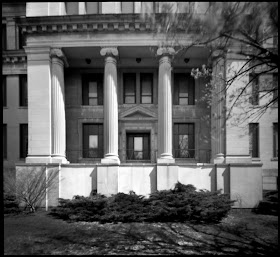Lately, I’ve been mostly doing posts based on a theme or project, but inevitably there are going to be a few exposures that just happen.
When I was testing the Little Black Cube, I was reminded why I like the New Evil Cube that it was based on so much. I loaded it up with Fomopan 100 and set out with no particular objective in mind.
Some of my favorite scenes downtown involve the First National Bank building looming over the smaller structures around it. I’ve photographed it with the narrow angle 200mm front for the Variable Cuboid a couple times, but with a wider angle camera like the 60mm Evil Cube, if you get close, the foreground buildings obscure the tall structure, and from farther away, there’s usually some big SUV in the foreground. (I know, in the pinhole world, 60mm is hardly extreme wide angle).
During the pandemic shutdown, the parking lot was empty. An unfortunate merger of the false front of the Beckwith Hotel building and the Bank. Would have been better if I’d moved to the left a couple feet.
Castle-Pierce Printing has a small sales office downtown with an antique press by the window featuring this big flywheel.
I’m always attracted to bricked over windows. I guess it was easier to put up a wall inside rather than build the scaffolding it would have taken to do it flush with the outside.
More bricked up windows and an obviously long abandoned loading dock. Anyone else think it looks like a cubist covered up that doorway?
Looking down the Fox toward Lake Winnebago.
Looking across the lake. The exposure was as fast as I could flip a card away from and back over the pinhole and short enough to capture waves on the surface.
Looking back at the clouds along the breakwater at Ames Point.
Then it was Worldwide Pinhole Photography Day. I did a series of self-portraits with Thin Lizzy and the 10th Anniversary iPhone box camera which included my submission to the WPPD gallery, but I still had a few frames left in the iPhone Box. It was a nice sunny day so I went outside.
The remnants of a hydrangea before it’s resurrection in the spring.
The south wall of the Sun Room, from the outside.
A close up of the ivy along the foundation.
There’s no reshooting since your photo has to be done on Pinhole Day, so I like to make at least a few exposures with a second camera, especially after the incident with the camera in the bath water. I still had the rest of the film in Evil Cube, so I continued with that.
The base of Sarah’s grandmother’s sewing machine that we rescued from a junk pile and has been a plant stand in the garden ever since.
A planter hung on the side door of the garage.
Spenser lying in the sun.
My last attempt for Pinhole Day with an exposure from 8:30 to midnight to catch the trails of the crescent moon and Venus setting in the west.
The Evil Cube has .3mm pinholes on the film axis and 10mm above the axis 60mm from a 6x6cm frame. It was loaded with Fomapan 100.
The 10th Anniversary iPhone Box camera has a .26mm pinhole 36mm from a 6x6cm frame. The film is Ilford Delta 400.
Both were semi-stand developed in Rodinal 1:100


















































